Messari: An In-Depth Look at the Product Architecture and Development Status of the DEX Aggregator 1inch
Original Author: Ramshreyas Rao
Original Title: "Bundling and Unbundling, 1inch by 1inch"
Translation: Hu Tao, Chain Catcher
Aggregating over 188 liquidity sources across 7 supported blockchains, with a trading volume exceeding $134 billion and over 1.6 million users, few DeFi projects embody Barksdale's famous declaration like 1inch Network. In December 2021, 1inch successfully raised $175 million in Series B funding, with a valuation of approximately $2.25 billion, led by Amber Group. This funding aims to explore regulatory spaces in Europe and the U.S., build a new 1inch protocol, expand the utility of the 1INCH token, and grow the contributor team.
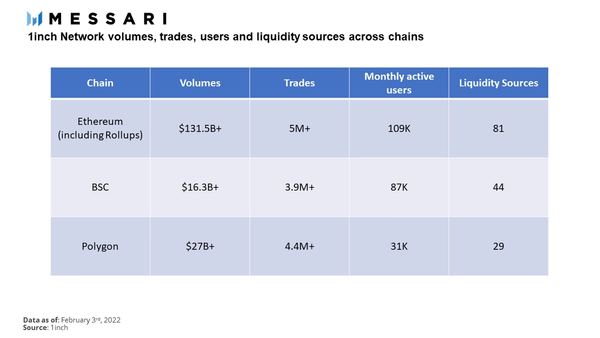
In an increasingly decentralized DEX environment, with numerous public chains, sidechains, Rollups, and their corresponding fee structures, liquidity, and slippage, the 1inch aggregator provides a single interface that automatically finds the best price for a given trading pair across multiple liquidity sources. But it is more than just a price comparison engine. The 1inch ecosystem consists of the following components:
- 1inch Wallet
- 1inch API
- 1inch Aggregation Protocol (DEX Aggregator)
- 1inch Limit Order Protocol
- 1inch DAO
- 1inch Foundation
2021 was a busy year for 1inch Network, with a series of innovations aimed at improving the DeFi user experience. Let's break it down.
Bundling DEX for Fun and Profit
At the core of 1inch's liquidity aggregation is Pathfinder - a routing algorithm that finds the most efficient token swap paths, splitting trades into multiple sub-trades across different protocols, and even different order depths within a protocol, to provide you with the best exchange rate.

In addition to optimizing trade rates, Pathfinder also reduces the likelihood of trade failures through its partial and dynamic filling mechanisms. When users submit a trade, Pathfinder first splits it into multiple liquidity sources. If the rate of one protocol changes unfavorably during this process, specific branches of that route can be canceled, and only favorable branches are executed.
Moreover, dynamic filling even allows amounts from unfavorable branches to be reallocated among favorable branches, and can be completed at the rates published in the interface. Users can also choose to optimize for the best rate or the lowest gas fee (up to 40%)—allowing Pathfinder to adjust its routing accordingly. All these options can be easily toggled from the trading interface.

With the latest V3 version of the 1inch Aggregation Protocol's code optimization, 1inch has become one of the most efficient decentralized trading solutions.

Since the end of 2020, the protocol has also allowed the use of collateral tokens in its routing, such as tokens minted on Aave and Compound. Such tokens need to be bundled or unbundled to be used in the route—this is automatically handled by 1inch under the hood.
Bundling is one of the oldest business models on the internet, and the 1inch contributor team has demonstrated exceptional execution in expanding the business. Few projects can claim that 1inch generates healthy order flow across all platforms it operates on through its single interface's liquidity sources and optimized listings.


User growth is also rapid, with returning users roughly matching new users.
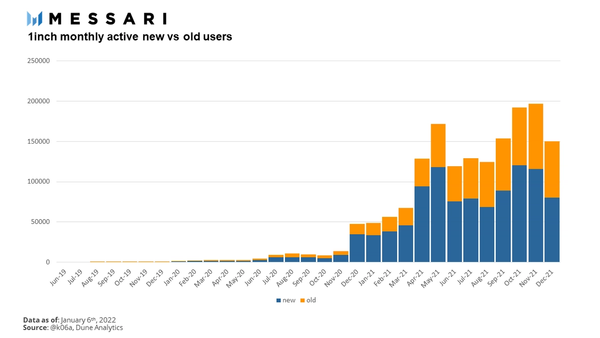
Unbundling 1inch AMM - Zero-Fee Limit Orders
1inch also offers its own centralized trading product with zero-fee limit order functionality. Most AMMs today only provide market orders, meaning that once a user places an order, it is executed immediately at the available market price. Limit orders are regular orders that execute only when the market reaches a predetermined price or better—typically used by more advanced traders who can analyze the market and assess the probability of reaching the limit price.
When a user places a limit order, it is added to a centralized database managed by 1inch. These orders can then be filled by any other user, including orders created by CEX and Pathfinder in the aggregation protocol. In addition to the trade value, the recipient of the limit order also includes gas costs, meaning this is a zero-fee order for users. This implementation also allows for dynamic pricing, conditional quotes set by users for execution, and quote requests (RFQ) for specific order sizes.
Version 2 of the 1inch Limit Order Protocol also facilitates gasless limit orders for ETH, allowing users with a zero ETH balance to swap supported tokens. This significantly lowers the entry barrier for new users/first-time users. Other improvements include extending permissions similar to DAI to more tokens, optimizing RFQs, etc.
Unbundling specific features (order types in AMMs) and providing unique selling propositions on that basis is another time-tested business model that 1inch executes well, with Ethereum's trading volume expected to exceed $800 million by January 2022.
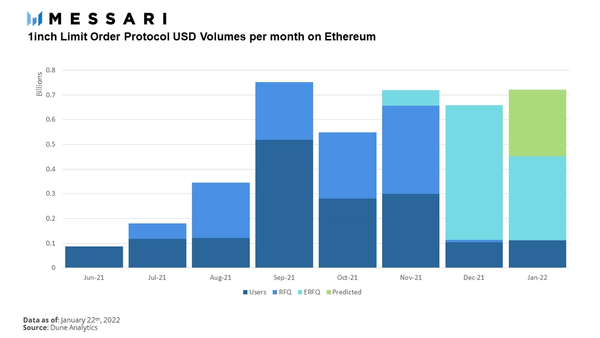
1inch DAO
1INCH token holders can vote on protocol parameters and governance proposals by staking their 1INCH tokens in the governance protocol. The DAO is implemented in two phases, with the first phase launched in December 2020. In this phase, the 1inch Foundation distributes 1INCH tokens to community members through "incentive activities" according to the lock release schedule. While stabilizing the protocol governance process, the initial core community is expected to implement DAO-based governance effectively.
The second phase is underway, which will achieve full control over the expanded governance mechanism and treasury—managed by the 1IP. Voting rights are obtained through holding st1INCH (non-transferable ERC-20 tokens representing 1INCH tokens staked in the protocol governance contract) and v1INCH (representing 1INCH tokens locked in the vesting contract for supporters/advisors/core contributors). Both can delegate their voting weight to other addresses.
Currently, an address belonging to Binance holds about 10% of the voting power, followed by around 6% stated on the governance page.

This concentration of power is due to the 1INCH staking pool on Binance, rather than individual whales holding 1INCH tokens. The 1inch team is waiting for community contributions and other categories to catch up with core contributors for a more even distribution.
1inch Token
The 1INCH token has two uses: as a utility token, 1INCH is used in liquidity protocols to achieve efficient routing. As a governance token, stakers of the token will be able to govern the protocol.
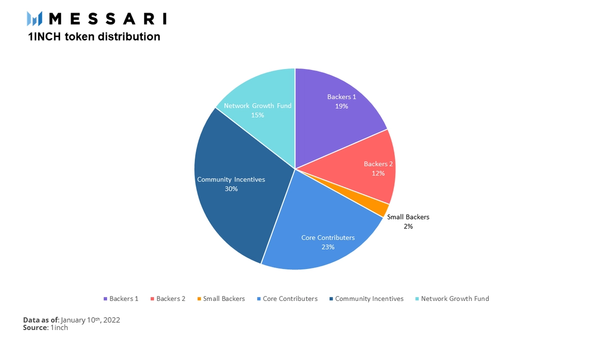
The 1inch community will hold 30% of the total supply of tokens, meaning that after the vesting period, most voting power remains in the hands of the core team, supporters, and investors. Of the 14.5% of the network growth fund, 8% was allocated to investors in the latest funding round.
1inch Foundation
The 1INCH token is issued by the 1inch Foundation, a non-profit organization dedicated to nurturing the 1inch network and community. It achieves this by attracting early adopters and increasing the number of users governing with 1INCH, granting funds to developers building on the 1inch protocol, and implementing yield farming programs aimed at incentivizing liquidity provision across the ecosystem.
Competition
1inch is a leading DEX aggregator on Ethereum, with a trading volume exceeding $130 billion. On both Ethereum and Polygon, 1inch is competing with the 0x protocol (Matcha is the 0x aggregator Dapp) for dominance.
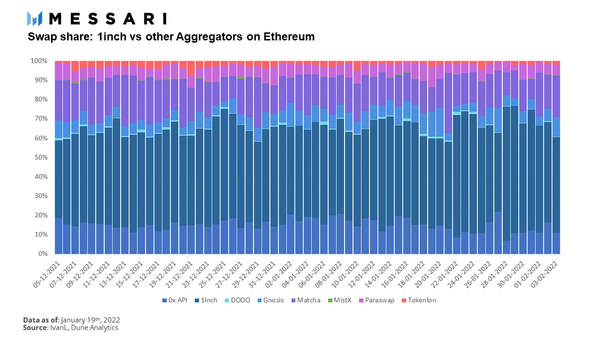
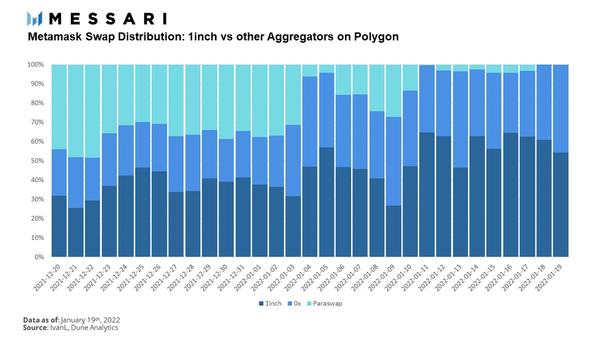
Ultimately, this is a game of bundling execution, where the winner will be determined by parameters such as fees, liquidity, availability of trading pairs, and integration with other important Dapps and protocols. Within this design space, some trade-offs are possible. Aggregation can occur not only at the DEX/Dapp level but also at the network level.
As competitors are essentially aggregating the same DEX and Dapp across chains (at least eventually), this space has matured for commoditization, with the competitor attracting the most liquidity and offering the lowest fees likely to prevail. Execution speed, as well as the speed of adoption and scaling, will be key drivers of success, and 1inch is well-positioned to maintain its dominance in this space for the time being.
The Road Ahead
1inch has demonstrated an exceptional ability to extract capital efficiency from the DEX ecosystem, along with outstanding execution in user acquisition and funding. However, the rise of alternative L1s opens new avenues for growth in two dimensions. The first is simply expanding the list of available DEXs and trading pairs. In fact, 1inch just expanded to Avalanche and Gnosis chains in 2022.
Another, more complex path is through cross-chain trading. One example is simply merging multiple chains and L2s into the routing algorithm. Another example is cross-chain staking—users can purchase tokens through 1inch on one chain and receive staking rewards from another chain. Despite the technical issues described by Vitalik Buterin, the multi-chain universe represents a new realm where 1inch can elevate its bundling and unbundling capabilities to new heights.










